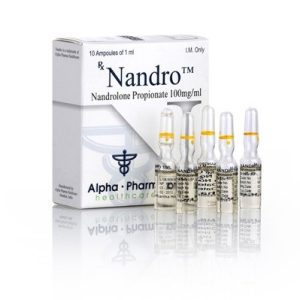$80.00
Slut i lager
Kategori:
Somatropin
The use of exogenous sources of Growth Hormone has been popular in the United States for almost 8 years now. Originally, athletes used biologically active forms that were the actual extract of the pituitary glands of cadavers. Ascellacrin and Crescormon were the two most popular brand names on this original GH. While production was under way on the synthetic, recombinant DNA versions of this drug, it was discovered that the biologically active form was associated with the formation of a rare brain virus called Creutzveldt Jacob Disease. This was a fatal virus that afflicted a very small number of GH users, none of whom were athletes. In light of this discovery, the FDA removed all of these natural GH versions from the market in the United States. Luckily, the synthetic recombinant versions were approved by the FDA a short time afterwards. These versions were developed after years of experiments with amino acid chains. The first of these versions was patented and produced by Genentech Labs with the brand name Protropin. A short time later, another form of synthetic Growth Hormone gained FDA approval. It was produced by Eli Lilly Labs and brand named Humatrope. This product was allowed to be patented because it was shown to be unique in that it contained a slightly different amino acid chain than the Protropin. The difference was that Humatrope had 191 amino acid chains in sequence and Protropin had 192. For some very complicated reasons, the 191 amino acid configuration has been shown to be more effective. It had been speculated that these synthetic versions of GH would greatly improve the cost effectiveness of using GH, yet that has not been the case. An athlete who wants to do a cycle of GH can still expect to be out as much as $4000 a month. There are numerous versions of Growth Hormone available in Europe, the majority of which are made up of the 191 amino acid sequence. There is even a form of the original human extract Growth Hormone, called Grorm which is available in a few countries. Although this drug is indicated for the treatment of pituitary deficient dwarfism, it has been used extensively by athletes who are attempting to alter their body composition. Growth Hormone itself, is an endogenous hormone produced by the pituitary gland. It exists at especially high levels during the teen years when it promotes growth of almost all tissues. It also contributes to the deposition of protein and promotes the breakdown of fat for use as energy.
MORE SOMATROPE INFORMATION
As the body reaches full maturation, the endogenous levels of GH are substantially diminished. After this, GH is still present in the body but at a substantially lower level where it continues to aid in protein synthesis, RNA and DNA reactions and the conversion of body fat to energy. By introducing an exogenous source of this hormone, athletes are hoping to promote these effects, causing the body to deposit more muscle tissue while at the same time reducing body fat stores. On paper, GH should work exceptionally well; however, it does not seem to be delivering up to its potential. Most athletes who have experimented with this product end up being disappointed. There is some evidence that exogenous sources of GH are being destroyed by antibodies which appear after the introduction of the synthetic compound. Although the 191 amino acid sequence versions have been shown to produce less of an antibody reaction, they are still not yielding consistent results. I have speculated as to whether the introduction of exogenous GH would yield an appreciable degree of efficacy simply due to the fact that the body does not have sufficient receptor affinity to GH in the post-teen years.A number of athletes claim that GH is not that effective on its own, but in a stack with steroids it can do remarkable things. Perhaps there is some type of actual synergism created by the concomitant use of these two agents. Empirical data suggests that the efficacy of GH is dose related and that the majority of users may not have been taking enough of it to get positive results. Despite speculation concerning its efficacy, synthetic GH is being used by thousands of elite athletes. These include men and women bodybuilders, strength athletes, as well as a multitude of Olympic competitors. Although Growth Hormone is banned by athletic committees, there is no method for the detection of it which allows drug tested competitors to use this product freely without any ramifications. Adverse reactions to GH use are rare but technically could involve acromegaly (elongation of the feet, forehead and hands). Other possible side effects involve overgrowth of the elbows or jaw, thickening of the skin and a type of diabetes. There are numerous counterfeit versions of this product which are merely cashing in on the drug’s mystique and high price tag. The legitimate versions must be refrigerated at all times, before and after they are reconstituted.

![Parabol (Trenbolone Hexa) Vedi-Pharma 10ml [76mg/ml]](https://steroidsftw.org/wp-content/uploads/2019/01/736-1200-Parabol-Trenbolone-Hexa-Vedi-Pharma-10ml-76mgml-300x300.jpg)
![Bolda Vedi-Pharma [Boldenonundecylenat] 10ml [300mg/ml]](https://steroidsftw.org/wp-content/uploads/2019/01/733-1197-Bolda-Vedi-Pharma-Boldenone-Undecylenate-10ml-300mgml-300x300.jpg)

SteroiderFTW är beläget i Europeiska unionen med 99% framgångsrik leveransgrad till Europa och USA.
KONTO
KONTAKTA OSS
STEROIDSFTW
Europeiska unionen
paul@steroidsftw.info